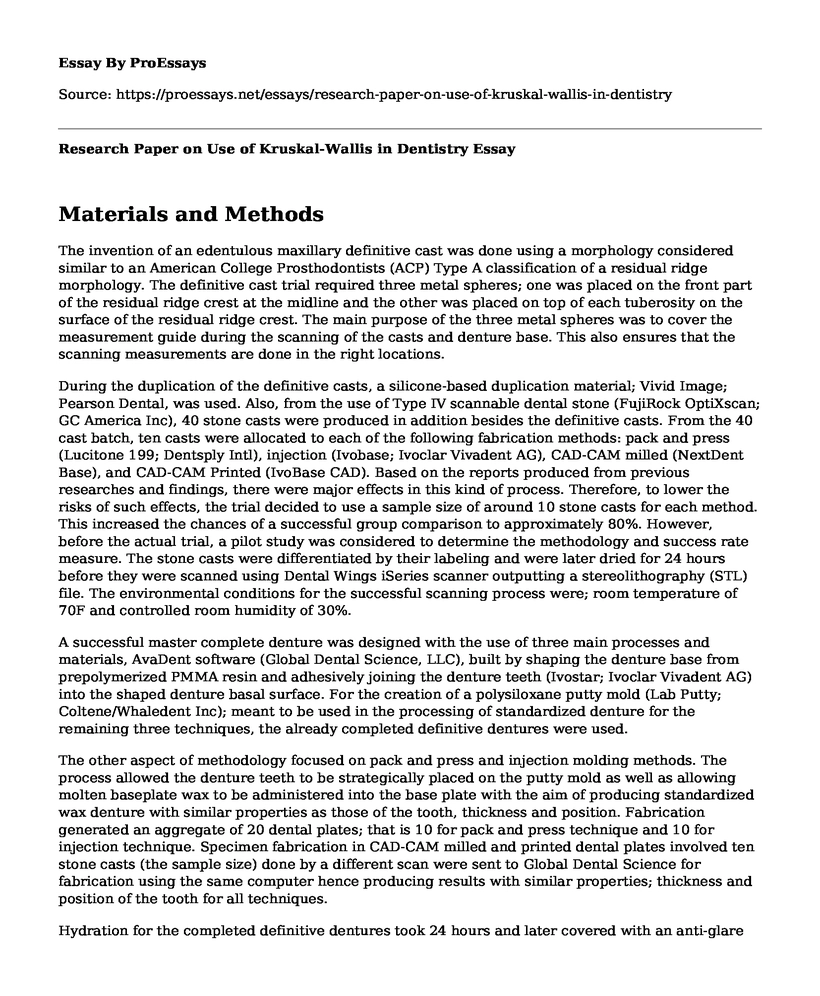Materials and Methods
The invention of an edentulous maxillary definitive cast was done using a morphology considered similar to an American College Prosthodontists (ACP) Type A classification of a residual ridge morphology. The definitive cast trial required three metal spheres; one was placed on the front part of the residual ridge crest at the midline and the other was placed on top of each tuberosity on the surface of the residual ridge crest. The main purpose of the three metal spheres was to cover the measurement guide during the scanning of the casts and denture base. This also ensures that the scanning measurements are done in the right locations.
During the duplication of the definitive casts, a silicone-based duplication material; Vivid Image; Pearson Dental, was used. Also, from the use of Type IV scannable dental stone (FujiRock OptiXscan; GC America Inc), 40 stone casts were produced in addition besides the definitive casts. From the 40 cast batch, ten casts were allocated to each of the following fabrication methods: pack and press (Lucitone 199; Dentsply Intl), injection (Ivobase; Ivoclar Vivadent AG), CAD-CAM milled (NextDent Base), and CAD-CAM Printed (IvoBase CAD). Based on the reports produced from previous researches and findings, there were major effects in this kind of process. Therefore, to lower the risks of such effects, the trial decided to use a sample size of around 10 stone casts for each method. This increased the chances of a successful group comparison to approximately 80%. However, before the actual trial, a pilot study was considered to determine the methodology and success rate measure. The stone casts were differentiated by their labeling and were later dried for 24 hours before they were scanned using Dental Wings iSeries scanner outputting a stereolithography (STL) file. The environmental conditions for the successful scanning process were; room temperature of 70F and controlled room humidity of 30%.
A successful master complete denture was designed with the use of three main processes and materials, AvaDent software (Global Dental Science, LLC), built by shaping the denture base from prepolymerized PMMA resin and adhesively joining the denture teeth (Ivostar; Ivoclar Vivadent AG) into the shaped denture basal surface. For the creation of a polysiloxane putty mold (Lab Putty; Coltene/Whaledent Inc); meant to be used in the processing of standardized denture for the remaining three techniques, the already completed definitive dentures were used.
The other aspect of methodology focused on pack and press and injection molding methods. The process allowed the denture teeth to be strategically placed on the putty mold as well as allowing molten baseplate wax to be administered into the base plate with the aim of producing standardized wax denture with similar properties as those of the tooth, thickness and position. Fabrication generated an aggregate of 20 dental plates; that is 10 for pack and press technique and 10 for injection technique. Specimen fabrication in CAD-CAM milled and printed dental plates involved ten stone casts (the sample size) done by a different scan were sent to Global Dental Science for fabrication using the same computer hence producing results with similar properties; thickness and position of the tooth for all techniques.
Hydration for the completed definitive dentures took 24 hours and later covered with an anti-glare splash ((3-D laser printing anti-glare sprig; Helling) with a standard ticleize of 2.8 mm. Dental Wings iSeries scanner was used to examine the intaglio surface of each denture which resulted to an STL file of each denture's intaglio surface. Superimposition of the STL document of every denture plate was undertaken on the STL record of the adjacent pre-fabricating cast utilizing a surface matching application (Geo-enchantment Regulator 2014; 3D Frameworks). Estimations were made using the application and were reported at 60 points for every 40 dentures utilizing an overlap manual to approve the locus of the 60 evaluations. Visual display was made in charts to indicate the adjustment of the denture base into the casts. The corresponding surfaces and measurements from the results provided opportunities for analysis of the inconsistent areas like apex of the denture border, 6 mm from denture border, crest of the ridge, palate, and posterior palatal seal.
The statistical significance and variations of the processing techniques followed the use of Kruskall-Wallis assessment of variance. The examination focused on the differences and similarities of the fabricating approaches in regards to location and significance of variation. The research considered 0.002mm as the standard error of recurrent approximations.
The Kruskal-Wallis process also assessed the average positions of misrepresentation among the fabricating strategies layered by the five areas of interest. Different trials also balanced the post hoc analyses. Finally, Levene test in regards to empirical evaluation was utilized to ascertain whether uniformity of the differences existed in fabricating methods. In that case, all trials of theories were 2-faced (a=.05).
Cite this page
Research Paper on Use of Kruskal-Wallis in Dentistry. (2022, Nov 06). Retrieved from https://proessays.net/essays/research-paper-on-use-of-kruskal-wallis-in-dentistry
If you are the original author of this essay and no longer wish to have it published on the ProEssays website, please click below to request its removal:
- Pulmonary Fibrosis
- Effects of Social Media in the Development of Community Health Nursing Essay
- Reflection on How the Health Care Course Has Played a Role in Goal Achievement
- South Africa Mental Health Challenges Paper Example
- Research Paper on Health People 2020: Reducing Type 2 Diabetes in the Hispanic Community
- Non-Pharmacologic Pain Management: Individualized Treatment Strategies - Essay Sample
- Article Review Example on Notes from Under the Dome: Pro-Life Stance by George McKenna







